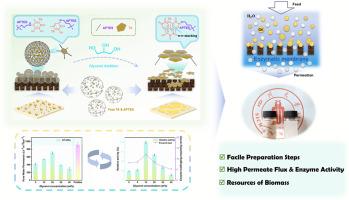A self-cleaning biocatalytic membrane with adjusted polyphenol deposition for edible oil-water separation
IF 4.1
2区 化学
Q2 POLYMER SCIENCE
引用次数: 0
Abstract
Catechol-amine co-deposition membranes have garnered significant interest in enzyme immobilization, yet the deposited coating leads to excessive mass transfer resistance, negatively impacting membrane filtration performance. This work adjusts polyphenol deposition by utilizing the co-deposition structure with tannic acid (TA) and 3-aminopropyltriethoxysilane (APTES) with glycerol to enhance the filtration capability while maintaining enzyme activity. The glycerol addition has brought in a structural transition from dense nanosphere stacking to the loose flaky structure of greater bulkiness. Consequently, the resulting membrane showed a 69 % of permeability improvement along with improved enzyme activity post-adjustment. In oil-water separation cycle tests, the biocatalytic membrane enabled the clarification of oil emulsions and facilitates offline self-cleaning, maintaining high permeability and recovery even after five cycles of heavy oil (4 g/L) filtration, showing great application potential in edible oil-water separation. The biocatalytic membrane of this work, derived from biomass and characterized by its facile preparation and minimal mass transfer resistance, presents a promising avenue for the integration of biocatalysis with filtration technologies within industrial production processes.


一种可调节多酚沉积的自清洁生物催化膜,用于食用油水分离
儿茶酚胺共沉积膜在酶固定化方面引起了极大的兴趣,但沉积的涂层会导致过度的传质阻力,对膜的过滤性能产生负面影响。本研究利用单宁酸(TA)和3-氨基丙基三乙氧基硅烷(APTES)与甘油共沉积结构调节多酚沉积,在保持酶活性的同时提高过滤能力。甘油的加入使结构从致密的纳米球堆积转变为体积较大的松散片状结构。因此,所得膜的通透性提高了69%,酶活性也随之提高。在油水分离循环试验中,生物催化膜能够对油乳进行澄清,并能实现离线自清洁,即使经过5次重油(4 g/L)过滤也能保持较高的渗透率和回收率,在食用油油水分离中具有很大的应用潜力。这项工作的生物催化膜来源于生物质,其特点是制备简单,传质阻力最小,为工业生产过程中生物催化与过滤技术的整合提供了一条有前途的途径。
本文章由计算机程序翻译,如有差异,请以英文原文为准。
求助全文
约1分钟内获得全文
求助全文
来源期刊

Polymer
化学-高分子科学
CiteScore
7.90
自引率
8.70%
发文量
959
审稿时长
32 days
期刊介绍:
Polymer is an interdisciplinary journal dedicated to publishing innovative and significant advances in Polymer Physics, Chemistry and Technology. We welcome submissions on polymer hybrids, nanocomposites, characterisation and self-assembly. Polymer also publishes work on the technological application of polymers in energy and optoelectronics.
The main scope is covered but not limited to the following core areas:
Polymer Materials
Nanocomposites and hybrid nanomaterials
Polymer blends, films, fibres, networks and porous materials
Physical Characterization
Characterisation, modelling and simulation* of molecular and materials properties in bulk, solution, and thin films
Polymer Engineering
Advanced multiscale processing methods
Polymer Synthesis, Modification and Self-assembly
Including designer polymer architectures, mechanisms and kinetics, and supramolecular polymerization
Technological Applications
Polymers for energy generation and storage
Polymer membranes for separation technology
Polymers for opto- and microelectronics.
文献相关原料
公司名称
产品信息
麦克林
graphite powders
麦克林
tannic acid
麦克林
3-aminopropyltriethoxysilane
麦克林
Tannic acid
麦克林
3-aminopropyltriethoxysilane
阿拉丁
p-nitrophenyl palmitate (p-NPP)
阿拉丁
p-nitrophenol (p-NP)
阿拉丁
p-nitrophenyl palmitate
阿拉丁
p-nitrophenol
阿拉丁
p-nitrophenyl palmitate (p-NPP)
阿拉丁
p-nitrophenol (p-NP)
 求助内容:
求助内容: 应助结果提醒方式:
应助结果提醒方式:


